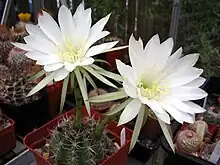Echinopsis albispinosa
Echinopsis albispinosa is a species of cactus from Argentina.[1] It should not be confused with Chamaecereus silvestrii.[2]
| Echinopsis albispinosa | |
|---|---|
 | |
| Scientific classification | |
| Kingdom: | Plantae |
| Clade: | Tracheophytes |
| Clade: | Angiosperms |
| Clade: | Eudicots |
| Order: | Caryophyllales |
| Family: | Cactaceae |
| Subfamily: | Cactoideae |
| Genus: | Echinopsis |
| Species: | E. albispinosa |
| Binomial name | |
| Echinopsis albispinosa K.Schum.[1] | |
| Synonyms | |
| |
Description
Echinopsis albispinosa usually grows singly, but occasionally branches and then forms small groups. The spherical to short cylindrical shoots reach heights of 5 to 10 centimeters with diameters of 4 to 8 centimeters. There are twelve to 14 ribs. The circular areoles on them are whitish. The single central spine protrudes. The five to nine marginal thorns lie on the surface of the shoot.
The long, tube-shaped, funnel-shaped, white flowers have no scent. They open at night. The flowers are up to 20 centimeters long.[3]
Distribution
Echinopsis albispinosa is widespread in the Argentine provinces of Salta and Tucumán at lower altitudes of 500 to 1000 meters.
Taxonomy
The first description by Carlos Luis Spegazzini was published in 1905.
References
- Anderson, Edward F. (2001), The Cactus Family, Pentland, Oregon: Timber Press, ISBN 978-0-88192-498-5, p. 280
- Anderson 2001, p. 262.
- Anderson, Edward F.; Eggli, Urs (2005). Das grosse Kakteen-Lexikon (in German). Stuttgart (Hohenheim): Ulmer. p. 243. ISBN 3-8001-4573-1.
External links
 Media related to Echinopsis albispinosa at Wikimedia Commons
Media related to Echinopsis albispinosa at Wikimedia Commons Data related to Echinopsis albispinosa at Wikispecies
Data related to Echinopsis albispinosa at Wikispecies